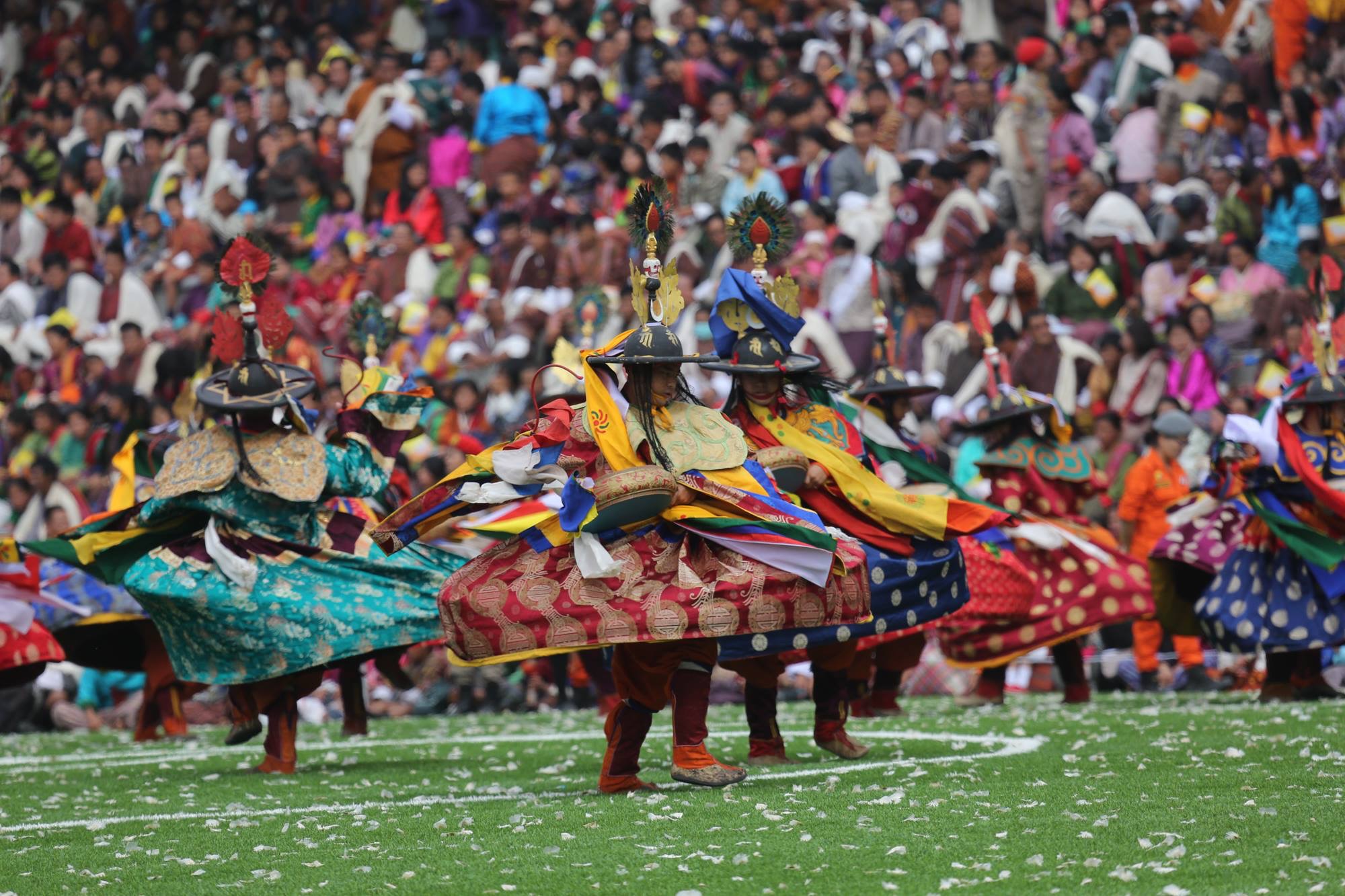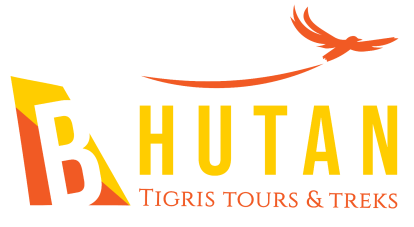Address
Bhutan Tigris Tours & Treks
Twins Building, Babesa Express Highway, Thimphu, Bhutan

Thimphu – 1N | Paro – 3N Gangtey – 1N | Punakha – 1N
6 Nights | 7 Days
Entry: Paro Exit: Paro
DAY 1│ARRIVAL IN PARO, BHUTAN
Elevation 2,320 m
Welcome to Bhutan, the Land of the Thunder Dragon. Touching down at Paro International Airport, you will be greeted by your guide upon exiting the arrival hall. Today, we will take it easy to accustom to the altitude. Drive to Thimphu, check in to the hotel and let’s have your first taste of Bhutanese cuisine.
National Memorial Chorten – Meet the elderly generation in moving around the Chorten.
Folk Heritage Museum – Dedicated to connecting people to the Bhutanese rural past though exhibition of artifacts used in rural households.
Textile Museum – Witnesses the art of traditional weaving.
Institute of Zorig Chusum – Commonly known as the Painting School, or the School of the Thirteen Arts, the Institute offers you a glimpse of novices learning 13 traditional arts and crafts of Bhutan. It is a hands-on trip for you. Enjoy few moments with future artists of the country.
DAY 2│THIMPHU TSHECHU
Elevation 2,320 m
Tashichhodzong (Thimphu Dzong) – The “fortress of the glorious religion” was initially constructed in 1641 and restored by the Third King Jigme Dorji Wangchuck in the 1960s. Tashichhodzong houses some offices, His Majesty’s secretariat, and the central monk body.
The Thimphu Tshechu, as all Tshechu festivals, honors Padma Sambhawa, also known as Guru Rimpoche, the precious yogi and saint who is credited with having introduced Tantric Buddhism throughout the Himalayas. The festival’s masked dances are performed by monks clad in colorful brocade attire and permeated by chants and reading of Buddhist scripts. The conclusion of festival constitutes the unfolding of a huge cloth thanka, a sacred scroll, depicting Padma Sambhawa and imagery from Buddhist pantheon.
Buddha Point – Located at Kuensel Phodrang, the 169 feet bronze statue of Buddha Dordenma, Vajra Throne Buddha symbolizing indestructibility. Visitors can drive up to the Buddha point and view the tallest statue of Lord Buddha. The view of Thimphu valley from the Buddha point is spectacular and beautiful, especially at night.
DAY 3│THIMPHU TO PUNAKHA
Elevation 1,300 m
Dochula Pass – The 108 chortens was built by the present Queen Mother of Bhutan Ashi Dorji Wangmo Wangchuck to commemorate Bhutan’s victory over Indian militants and to liberate the souls of the souls lost.
Punakha Dzong – Built in 1637, the dzong continues to be the winter home for the clergy, headed by the Chief Abbott, the Je Khenpo. It is a stunning example of Bhutanese architecture, sitting at the fork of two rivers, portraying the image of a medieval city from a distance. The dzong was destroyed by fire and glacial floods over the years but has been carefully restored and is, today, a fine example of Bhutanese craftsmanship.
Khamsum Yulley Namgyal Chorten – Built by the third Queen Mother Ashi Tshering Yangdon wangchuck this Chorten is a splendid example of the Bhutanese architecture and art and is the only one of its kind in the world. It has been built over eight and a half years and its details have been drawn from religious scripture.
DAY 4│PUNAKHA TO GANGTEY
Elevation 3,000 m
Chhimi Lhakhang – A 20 minutes’ walk across terraced fields through the village of Sopsokha. Ngawang Chogyel built the temple in 15th century after the ’divine Madman’ Drukpa Kuenlay built a small chorten there.
Passing Wangdue (left), one of the major towns and district capital of Western Bhutan. Located south of Punakha, Wangdue is the last town before central Bhutan. The district is famous for its fine bamboo work and its slate and stone carving.
We will pause to view the Wangdue Phodrang Dzong. Built in 1638, Wangdue Dzong is dramatically perched on the spur of a hill and overlooks the confluence of the Tsang Chu and Dang Chu rivers.
DAY 5│GANGTEY TO PARO
Elevation 2,280 m
Drukgyel Dzong – A morning drive, north of Paro valley brings us to the ruins of Drukgyel Dzong. Built in 1647 by the great Zhabdrung Ngawang Namgyal, father and unifier of medieval Bhutan, the Dzong was destroyed by an accidental fire and left in ruins as an evocative reminder of the great victories it was built to commemorate. Explore the ramparts and relive the memories of a glorious past.
Ta Dzong – Built as a watch tower the Ta Dzong, it was converted into the National Museum in 1968. The museum boasts antique Thangka, textiles, weapons and armor, household objects and rich variety of natural and historic artifacts.
Paro Valley – The beautiful valley is home to many of Bhutan’s old monasteries and temples. The country’s only Airport is in Paro. The valley is also home to mount Chomolhari (7,300 meters) situated at the northern end of the valley whose glacier water forms the Pachu flowing through the valley. The following are some of the prominent places to visit in Paro.
DAY 6│PARO
Elevation 2,280 m
Paro Dzong also known as Rinpung Dzong, this 15th century massive fortress/monastery, is also the administrative center of the dzongkhag.
Taktsang Monastery – A one-hour hike to the cafeteria is also an indelible view whereby you can enjoy the stunning view of the monastery. Prayer flags adorn the cliffs and this is also where Guru Padmasambhava landed on the back of a tigress in the 8th century.
Duration: 5-7 hours depending on time taken in monasteries
Difficulty: Moderate – Guided with mineral water
DAY 7│DEPART FROM PARO
Elevation 2,280 m
Today we will bid fond farewell to this beautiful Himalayan country and take an early flight back to respective country. We hope by now you would have made some friends and also kept many photos and beautiful reminiscences of Bhutan! And we look forward to seeing you again in this beautiful land of endless Fascinations!
The accommodation is certified by Tourism Council (TCB) and hotel Association of Bhutan. (HAB)
A Good condition sightseeing vehicle will be allocated for the tour to ensure smooth travel. Depending on the no of tourists traveling, our agent shall reserve the right to best assign the vehicle as given below;
2 Pax – Santa Fe, Creta, Tucson etc
4 – 6 Pax – Santa Fe, Creta / Hi ace bus will be most comfortable
8 Pax and above – Coaster Bus
A skilled and highly experience guide certified by Guide Association (GAB) and Tourism Council of Bhutan (TCB) will be allocated to lead the tour throughout.
